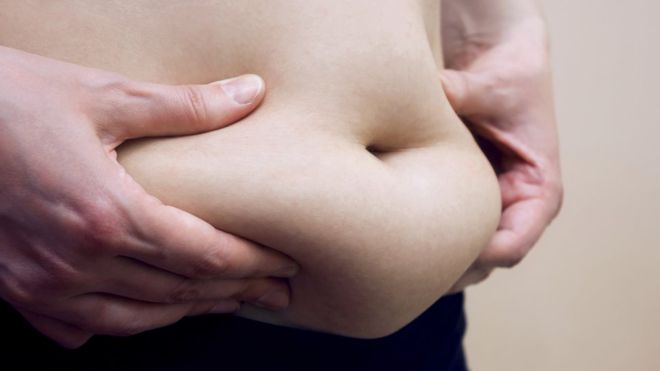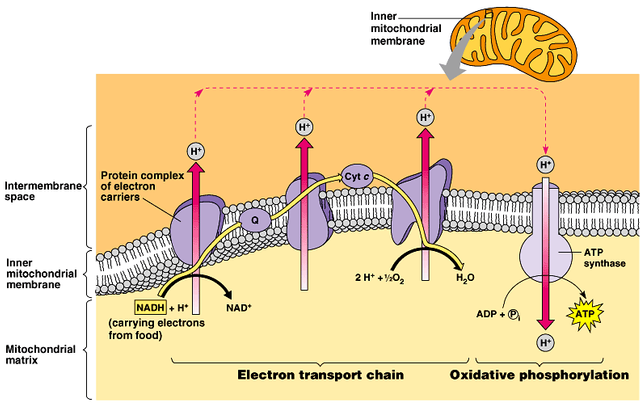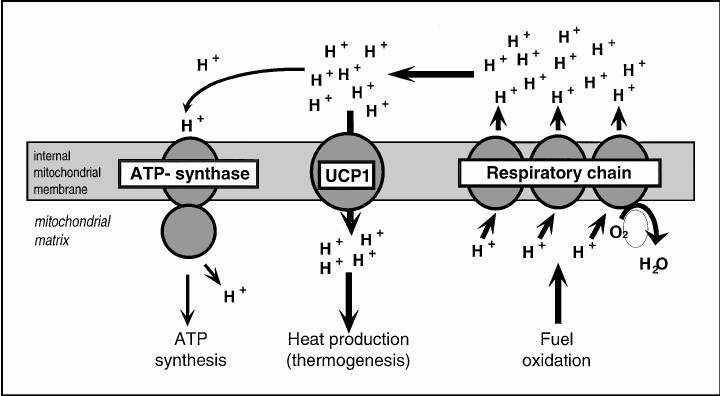The fat that makes you thin – What is brown fat?
When most people think of fat, they will probably picture a tyre of flab lingering around the midriff (or something of the sort), much like the image below. This is known as white adipose tissue, the main type of fat that is present in the human body. Used primarily as an energy store, but now also thought of as an endocrine organ, large quantities of white adipose tissue is what makes us obese.

figure 1. Subcutaneous stomach fat
However, there is a second type of fat present in the body, known as brown adipose tissue. Unlike white adipose tissue, brown fat contains many mitochondria and functions to consume energy and produce heat.
How can this brown fat make you thin?
Since brown adipose tissue functions to generate heat through energy consumption, it follows that the greater quantity of brown fat a person possesses the greater their basal metabolic rate will be. With a higher metabolic rate, a person will burn more calories at rest as a result of this brown fat. Ultimately, this allows them to store less energy from a given amount of food than a person with less brown fat, as more energy is wasted as heat. It was originally thought that only babies had brown adipose tissue, but it has now been identified within adults. Additionally, it appears those with more brown adipose tissue do indeed have a lower BMI on average, as detailed in this study.
How does brown fat consume energy and generate heat?
It is due firstly to the fact brown adipose tissue contains a lot of mitochondria, the organelle responsible for generating energy within a cell. But also, the mitochondria within brown adipose tissue contain a unique protein called uncoupling protein-1 (UCP1). The UCP1 influences the function of mitochondria to make them less energy efficient and waste more energy as heat.
An understanding of oxidative phosphorylation is required to be able to interpret how UCP1 is able to do this.

figure 2. Oxidative phosphorylation
Firstly, we have a H+ gradient being built up across the inner mitochondrial membrane, and this is known as the proton motive force. The energy to build up this proton motive force is provided by electrons donated from the cofactors NADH and FADH2. In normal mitochondria the inner mitochondrial membrane is not permeable to H+, meaning the only way to dissipate the proton motive force is through the enzyme ATP synthase. As the H+ ions move through ATP synthase, their energy is used to form ATP from ADP and Pi, thus generating the energy currency required for biochemical reactions.
This is where the difference occurs in brown fat mitochondria. The UCP1 is able to uncouple the inner mitochondrial membrane. This occurs because UCP1 allows H+ to move back across the inner mitochondrial membrane, down their concentration gradient, without passing through ATP synthase. In short, UCP1 makes the inner membrane permeable to H+. Providing this alternative route for H+ means that fewer of these ions will move through ATP synthase, and less ATP will be produced from the same quantity of NADH and FADH2 (which are made via processes using glucose or other nutrients). By uncoupling the mitochondrial membrane in this way, instead of becoming ATP, the additional energy is dissipated as heat. This mechanism is depicted below.

figure 3. Mechanism of action of UCP1
So, people need no longer worry about what they eat? The problems of obesity could be a thing of the past?
All we need to do is increase the quantity of brown fat. Unfortunately, this is far easier said than done. While studies show that brown adipose tissue is increased in cold environments, so far, there is no way to increase the quantity of brown fat within the body. Some people will just have more of it than others. Despite this, weight loss pills using the principle of uncoupling that occurs in brown fat do exist.
Would an uncoupling weight loss pill be a good thing?
The most common pill used to uncouple the inner mitochondrial membrane and generate heat (much like UCP1) is dinitrophenol (DNP). By uncoupling the mitochondria of many cells in the body, the person taking the pill will generate more heat and their basal metabolic rate will increase resulting in weight loss.
Taken in excess, however, DNP can have awful consequences. If an overdose of this pill is taken, the body can heat up beyond any normal levels, and this has resulted in numerous deaths. With people taking DNP, with their body becoming temperature becoming unregulated by normal mechanisms, resulting in death through hyperthermia. Due to this, DNP should not be used to combat weight loss, and is extremely dangerous. Once an overdose is taken, the symptoms of hyperthermia and death are rarely reversible.
Perhaps, brown adipose tissue can be harnessed in a much safer way than DNP. But any drug that uncouples mitochondria in this way should be treated with extreme caution, especially considering the devastating effects that DNP can have.
References:
White adipose tissue
Brown adipose tissue
Physiology of brown adipose tissue
It takes about a week of training before your body recruits enough brown fat for it to have a meaningful impact on your metabolism.
Thanks, I did not know this. From the studies I read when researching for this post, it seems extremely difficult to increase the quantity of brown adipose tissue within the body.
I am also fat
Interesting! I don't understand why people buy pills like this instead of moving?
I imagine taking weight loss pills are taken by some people as a last resort. Those who feel as though they have tried lots of methods to lose weight, with little success. Even so, DNP is still extremely dangerous, and should not be used under any circumstance.
They need more broccoli!
This is really educative, I really enjoyed reading this post . I would suggest you post something that can help people like myself remove the white adipose tissue in the lower abdominal region. Thanks for sharing
Cheers
I am glad that you found it informative. I will do my best to research on targeting white adipose tissue and see if I can put a post together!
I cool that would be really nice, it would bring a lot of attention down because most people with lower belly fat are looking for easier way that are less time consuming to remove them .
Congratulations @ovij, this post is the eighth most rewarded post (based on pending payouts) in the last 12 hours written by a User account holder (accounts that hold between 0.1 and 1.0 Mega Vests). The total number of posts by User account holders during this period was 1615 and the total pending payments to posts in this category was $3511.40. To see the full list of highest paid posts across all accounts categories, click here.
If you do not wish to receive these messages in future, please reply stop to this comment.
Leaned something new today :) I heard about brown and white fat before but never know the function of brown fat.
Thanks, glad you enjoyed it, and learnt something new!
This is incredible! Love it. @ovij
A great post. @ovij followedd
This post recieved an upvote from minnowpond. If you would like to recieve upvotes from minnowpond on all your posts, simply FOLLOW @minnowpond
Health should always prioritize, thanks for sharing such information which is really informative